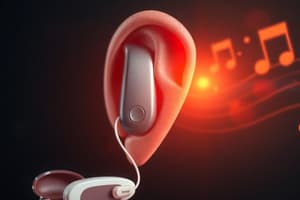Podcast
Questions and Answers
What is Real Ear Measurement (REM)?
What is Real Ear Measurement (REM)?
- Measurement of amplified OP of a HA in an individual’s ear canal (correct)
- Measurement of acoustic modifications in the ear canal
- Measurement of unamplified sound in the external ear
- Measurement of middle ear impedance
What is the aim of Real Ear Measurement (REM)?
What is the aim of Real Ear Measurement (REM)?
- To improve the quality of the selection, fitting, and verification of the fitting of hearing aids (correct)
- To assess the physical features of the middle ear
- To measure unamplified sound in the ear canal
- To measure the size of the external ear
What are the factors significantly affecting the electroacoustic characteristics of a hearing aid?
What are the factors significantly affecting the electroacoustic characteristics of a hearing aid?
- Age, gender, and occupation of the individual using the hearing aid
- Type and features of the hearing aid, acoustic modifications, physical features of the external ear, ear canal, and middle ear (correct)
- Brand name, warranty, and price of the hearing aid
- Battery type, color, and size of the hearing aid
Why carry out Real Ear Measurements (REMs)?
Why carry out Real Ear Measurements (REMs)?
What is the purpose of HA verification?
What is the purpose of HA verification?
Why do some audiologists avoid verifying the performance of HAs?
Why do some audiologists avoid verifying the performance of HAs?
What does HA validation refer to?
What does HA validation refer to?
What is included in treatment efficacy for HAs?
What is included in treatment efficacy for HAs?
What is the main concern for some audiologists regarding HA verification?
What is the main concern for some audiologists regarding HA verification?
Flashcards are hidden until you start studying
Study Notes
Real Ear Measurement (REM)
- REM is a technique used to assess the performance of hearing aids directly in the patient's ear canal.
- It measures the sound produced by the hearing aid in real-time, providing specific data on how the device works for the individual user.
Aim of Real Ear Measurement (REM)
- The main goal is to ensure that hearing aids are fine-tuned to provide optimal amplification suitable for a user's unique auditory profile.
- It aims to align the output of hearing aids with prescriptive fitting formulas for the best possible hearing outcomes.
Factors Affecting Electroacoustic Characteristics of Hearing Aids
- The physical shape of a patient's ear can influence how sound waves travel and resonate.
- Variations in ear canal volume lead to differences in sound pressure levels experienced by patients.
- Hearing aid positioning affects the way sound enters the ear and interacts with the ear canal.
Reasons to Carry Out Real Ear Measurements (REMs)
- To customize hearing aids for individual users, enhancing sound quality and listening experience.
- To verify that the hearing aids meet the desired amplification targets as per standardized fitting protocols.
Purpose of Hearing Aid (HA) Verification
- HA verification ensures that the devices are functioning correctly and delivering appropriate amplification as intended by audiological recommendations.
- It involves objective measurements to confirm that the device settings produce a suitable auditory response.
Reasons Some Audiologists Avoid HA Verification
- Concerns over time constraints during patient appointments may lead to the bypassing of verification processes.
- Lack of familiarity or comfort with REM equipment can deter some audiologists from performing these assessments.
Hearing Aid Validation
- Validation refers to evaluating the subjective benefits a patient experiences while using a hearing aid.
- It assesses whether the hearing aid meets the user's needs and preferences in real-world scenarios.
Treatment Efficacy for Hearing Aids
- Treatment efficacy includes both objective measures, like REM, and subjective evaluations, assessing user satisfaction and improvement in communication.
- It encompasses functional outcomes, such as improved speech recognition and overall quality of life for users.
Main Concerns for Audiologists Regarding HA Verification
- Some audiologists worry that verification processes may lead to patient dissatisfaction if the sound quality is not suitable for individual preferences.
- There may also be apprehension about over-reliance on objective measurements rather than considering subjective experiences of hearing aid users.
Studying That Suits You
Use AI to generate personalized quizzes and flashcards to suit your learning preferences.




